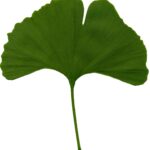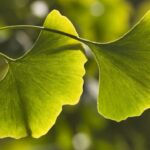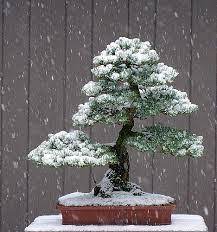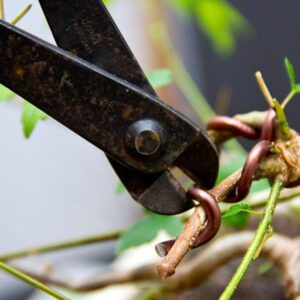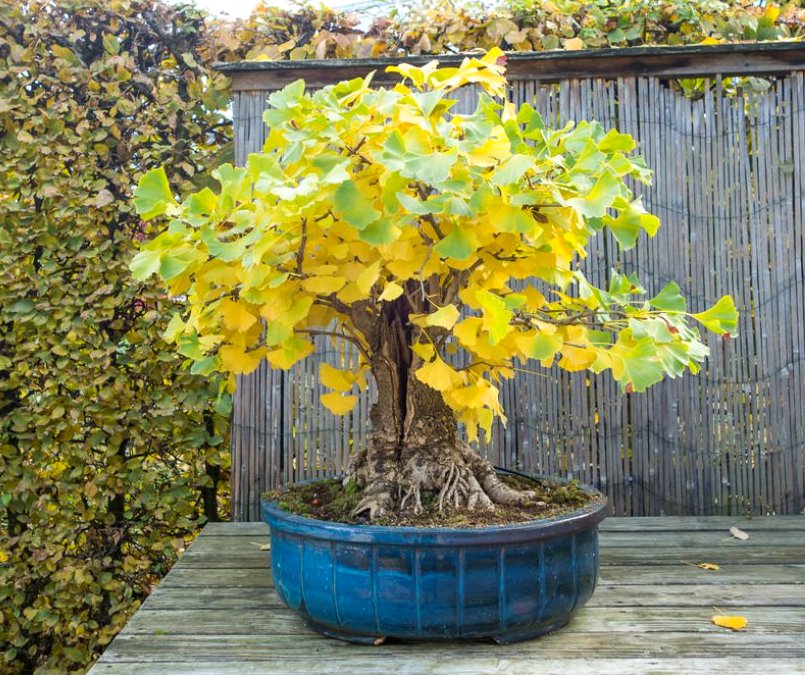
GINKGO (Ginkgo biloba), also called Maidenhair Tree
Revered for its beauty and longevity, the Ginkgo is a living fossil, unchanged for more than 200 million years. It is a single species with no known living relatives. It has survived the great ice ages as a relic in China. A living link to the age of dinosaurs, still here today. The oldest recorded ginkgo tree is 3,500 years old.
Ginkgo is a deciduous gymnosperm tree (family Ginkgoaceae) native to China. The fissured bark is grayish, deeply furrowed on older trees, and has a corky texture. The light-colored wood is soft and weak. Fan-shaped ginkgo leaves resemble the maidenhair fern leaflets and are borne on short, spurlike, but significantly thickened shoots.
Most leaves are divided into two lobes by a central notch. Dull gray-green to yellow-green in summer, the leaves of the Ginkgo turn bright yellow in autumn before they fall. The bark of the Ginkgo is very easily bruised and damaged therefore making it hard to wire.
There are male and female trees. Male trees are preferred because the ripe fruit of the female ginkgo has a very unpleasant smell, somewhat of rancid meat. Thankfully, bonsai ginkgo hardly ever bears fruit, so this is not of much importance.
It is thought the leaves tell the tale. Male leaves have two-lobed leaves with a notch in the center, while females are like fans. But there is evidence that the Ginkgo has changed sexes to accommodate fertilization.
Ginkgoes have long been valued for their healing and medicinal properties. Today we see ginkgo biloba being sold widely in health food stores.
INTERESTING FACT:
Extreme examples of the Ginkgo’s tenacity may be seen in Hiroshima, Japan, where six trees growing between 1–2 kilometers (1⁄2–1+1⁄4 miles) from the 1945 atom bomb explosion were among the few living things in the area to survive the blast. Although all other plants (and animals) in the area were killed, the ginkgo, though charred, survived and were soon healthy again. And they are still alive today.
STYLING: Clump, straight trunk, curved trunk, broom. Because this bonsai resents being pruned, it is best to style your Ginkgo based on their natural inclinations toward a column or flame-shaped tree.
PLACEMENT: Ginkgo are robust and can grow in diverse soils and conditions. Place the Ginkgo outside all year round. Your ginkgo bonsai will thrive in full sun to partial shade. Maximum light for mature trees will help ensure the best autumn color, while younger trees will benefit from some protection in the hottest part of the summer during the middle of the day. The Ginkgo can endure frost, but when it is planted in a bonsai pot, the root ball should be protected to keep the roots from freezing for prolonged periods.
WATERING: Be sure to water well in the growing season. Lessen the amount in the winter, keeping roots barely moist, just enough to keep it from drying out completely.
FERTILIZING: Begin fertilizing when the buds begin to open. Use high nitrogen fertilizer in spring to make the tree grow long shoots. Otherwise, especially older ginkgo bonsai might only produce leaves on short shoots, and the ramification will not improve. Use liquid fertilizer every week until the leaves turn yellow in autumn. Solid organic fertilizer can also be used. If the plant’s vigor must be increased, use both solid and liquid fertilizer.
PRUNING AND WIRING: The Ginkgo is quite a fast-growing tree. Unfortunately, pruning the Ginkgo produces scars that do not heal. Therefore, any pruning should be done extremely carefully. Do not make concave cuts or even cut flush to the trunk. Instead, leave short stubs of old branches, and remove them gently a year or so later as they dry out. The best time to prune the Ginkgo is in the spring and fall, at which time the clusters of leaves should be reduced to about two to three leaves, keeping the topmost leaf on the outside. New branches should be cut back to two or three buds when the tree is young. To keep the desired shape, you need to top it off regularly. To maintain balance and symmetry, you might need to do a little wiring, but usually, little is desired because the bark of this tree is delicate and requires minimal light wiring using raffia to protect the bark and the most lightweight aluminum wire possible.
I acquired a small Ginkgo, and I was told to plunk my tree into the ground and let it go for several years to thicken the trunk and not prune it or top it, just let it grow, and it sure does. I put mine into the ground over a year ago, and it is as tall as I am, and the trunk has thickened nicely. Another couple of years and into a pot, it will go. It IS a fast grower.
REPOTTING: Repot your Ginkgo every one to five years, depending on the age and growth rate of the tree (less frequently for older trees). Before new growth begins, it is best to repot in the spring, providing extra protection from late frosts. Root prune lightly, as they will not tolerate severe root reduction. A standard soil mix is fine, but it must be well-draining.
PESTS AND DISEASES: The Ginkgo is very resistant and is hardly ever attacked by insects or fungal diseases. It’s just a good old tough tree.
PROPAGATION: The ginkgo tree can be propagated from seeds and cuttings. Air-layering is also possible. The seeds have a hard shell and should be stratified or scarified before they are planted. It can take up to two years until they germinate.
Submitted by Charlotte Field
References: Encyclopedia Britannica, Ginkgo: The Tree That Time Forgot – by Botanist Peter Crane, Bonsai Empire, Wikipedia

